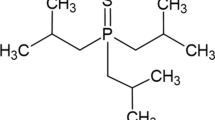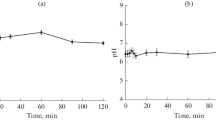Abstract
Mercury extraction has been studied in nitric and hydrochloric acids with hexathia-18-crown-6 dissolved in carbon tetrachloride. Batch study experiments have been performed to determine the best conditions for maximum extraction. In both acids, Hg(II) was best extracted at low molarity while almost no extraction was observed above 2 M. Speciation studies were carried out in an attempt to describe the extraction mechanism, but the exact composition of the extracted species was not determined. The extraction kinetics were studied to assess the feasibility of this crown ether for extracting Cn and/or Fl in a future online experiment.




Similar content being viewed by others
References
Karol PJ, Barber RC, Sherill BM et al (2016) Discovery of the element with atomic number Z = 118 completing the 7th row of the periodic table (IUPAC Technical Report). Pure Appl Chem 88:155–160. https://doi.org/10.1515/pac-2015-0501
Choppin G, Liljenzin J-O, Rydberg J, Ekberg C (eds) (2013) Chapter 14—the actinide and transactinide elements. In: Radiochemistry and nuclear chemistry, 4th ed. Academic Press, Oxford, pp 405–444
Fricke B (1975) Superheavy elements a prediction of their chemical and physical properties. Struct Bond Berl Ger 21:89–144
Pyykko P, Desclaux J-P (1979) Relativity and the periodic system of elements. Acc Chem Res 12:276–281. https://doi.org/10.1021/ar50140a002
Schwerdtfeger P, Seth M (2002) Relativistic effects of the superheavy elements. In: Von Rague Schleyer P (ed) Encyclopedia of computational chemistry. Wiley, New York, pp 2480–2499
Türler A, Pershina V (2013) Advances in the production and chemistry of the heaviest elements. Chem Rev 113:1237–1312. https://doi.org/10.1021/cr3002438
Pershina VG (1996) Electronic structure and properties of the transactinides and their compounds. Chem Rev 96:1977–2010. https://doi.org/10.1021/cr941182g
Schädel M (2015) Chemistry of the superheavy elements. Philos Trans R Soc Math Phys Eng Sci 373:20140191. https://doi.org/10.1098/rsta.2014.0191
Eichler R, Aksenov NV, Belozerov AV et al (2008) Thermochemical and physical properties of element 112. Angew Chem Int Ed 47:3262–3266. https://doi.org/10.1002/anie.200705019
Eichler R, Aksenov NV, Belozerov AV et al (2007) Chemical characterization of element 112. Nature 447:72–75. https://doi.org/10.1038/nature05761
Eichler R, Aksenov NV, Belozerov AV et al (2007) Confirmation of the decay of 283112 and first indication for Hg-like behavior of element 112. Nuclear Phys A 787:373–380. https://doi.org/10.1016/j.nuclphysa.2006.12.058
Yakushev A, Gates JM, Türler A et al (2014) Superheavy element flerovium (element 114) is a volatile metal. Inorg Chem 53:1624–1629. https://doi.org/10.1021/ic4026766
Eichler R, Aksenov NV, Albin YuV et al (2010) Indication for a volatile element 114. Radiochim Acta 98:133–139. https://doi.org/10.1524/ract.2010.1705
Pitzer KS (1975) Are elements 112, 114, and 118 relatively inert gases? J Chem Phys 63:1032–1033. https://doi.org/10.1063/1.431398
Liu W, van Wüllen C, Han YK, et al (2001) Spectroscopic constants of Pb and Eka-lead compounds: comparison of different approaches. In: Advances in quantum chemistry. Academic Press, Cambridge, pp 325–355
Nash CS (2005) Atomic and molecular properties of elements 112, 114, and 118. J Phys Chem A 109:3493–3500. https://doi.org/10.1021/jp050736o
Hoffman DC, Lee DM, Pershina V (2006) Transactinide elements and future elements. In: Morss LR, Edelstein NM, Fuger J (eds) The chemistry of the actinide and transactinide elements. Springer, Dordrecht, pp 1652–1752
Pershina V (2010) Electronic structure and chemistry of the heaviest elements. In: Barysz M, Ishikawa Y (eds) Relativistic methods for chemists. Springer, Dordrecht, pp 451–520
Gäggeler HW, Türler A (2014) Gas-phase chemistry of superheavy elements. In: Schädel M, Shaughnessy D (eds) The chemistry of superheavy elements. Springer, Berlin, pp 415–483
Despotopulos JD, Kmak KN, Gharibyan N et al (2018) Studies of the homologs and pseudo-homologs of flerovium with crown ether based extraction chromatography resins. J Radioanal Nucl Chem 318:1821–1826. https://doi.org/10.1007/s10967-018-6207-4
Omtvedt JP, Alstad J, Bjørnstad T et al (2007) Chemical properties of the transactinide elements studied in liquid phase with SISAK. Eur Phys J D 45:91–97. https://doi.org/10.1140/epjd/e2007-00214-6
Düllmann ChE, Schädel M, Yakushev A et al (2010) Production and decay of element 114: high cross sections and the new nucleus 277Hs. Phys Rev Lett 104:252701. https://doi.org/10.1103/PhysRevLett.104.252701
Guillaumont R, Adloff JP, Peneloux A (1989) Kinetic and thermodynamic aspects of tracer-scale and single atom chemistry. Radiochim Acta 46:169–176. https://doi.org/10.1524/ract.1989.46.4.169
Kratz JV, Nagame Y (2014) Liquid-phase chemistry of superheavy elements. In: Schädel M, Shaughnessy D (eds) The chemistry of superheavy elements. Springer, Berlin, pp 309–374
Sekido E, Saito K, Naganuma Y, Kumazaki H (1985) Liquid–liquid extraction of some class b metal ions with thiacrown ether 1, 4, 8, 11-tetrathiacyclotetradecane. Anal Sci 1:363–368. https://doi.org/10.2116/analsci.1.363
Baumann TF, Reynolds JG, Fox GA (2000) Polymer pendant crown thioethers: synthesis, characterization and Hg2+ extraction studies of polymer-supported thiacrowns ([14]aneS4 and [17]aneS5). React Funct Polym 44:111–120. https://doi.org/10.1016/S1381-5148(99)00085-1
Nelson AJ, Reynolds JG, Baumann TF, Fox GA (2000) X-ray photoemission investigation of binding sites in polymer-bound thiacrowns used for environmental remediation of Hg in aqueous solutions. Appl Surf Sci 167:205–215. https://doi.org/10.1016/S0169-4332(00)00523-7
Baumann TF, Reynolds JG, Fox GA (1998) Polymer pendant crown thioethers: synthesis and HgII extraction studies of a novel thiacrown polymer. Chem Commun. https://doi.org/10.1039/A803383H
Jenkins HA, Loeb SJ, Riera AM (1996) Tetranuclear Ag(I) complexes with an octagonal Ag4S4 core: building large structures from small macrocycles. Inorganica Chim Acta 246:207–215. https://doi.org/10.1016/0020-1693(96)05067-0
Heitzsch O, Gloe K, Stephan H, Weber E (1994) Liquid–liquid extraction of Ag(I), Hg(II), Au(III) and Pd(II) by some oligothia macrocyclic ligands incorporating aromatic and heteroaromatic subunits. Solvent Extr Ion Exch 12:475–496. https://doi.org/10.1080/07366299408918220
Robilotto TJ (2010) Synthesis and characterization of (phospine)- and (N-heterocyclic carbene)gold(I) halides, azides, alkynyls, triazoles, and dendrimers and the synthesis and characterization of gold(I) thiacrown macrocycles. Case Western Reserve University School of Graduate Studies
Setzer WN, Tang Y, Grant GJ, VanDerveer DG (1992) Synthesis and complexation studies of mesocyclic and macrocyclic polythioethers. 9. Crystal and molecular structure of (1,4,7,10,13-pentathiacyclopentadecane)cadmium(II) perchlorate hydrate: a seven-coordinate cadmium. Inorg Chem 31:1116–1118. https://doi.org/10.1021/ic00032a041
DeSimone RE, Glick MD (1976) Structures of the macrocyclic polythiaether 1,4,8,11-tetrathiacyclotetradecane and implications for transition-metal chemistry. J Am Chem Soc 98:762–767. https://doi.org/10.1021/ja00419a020
Blake AJ, Gould RO, Reid G, Schröder M (1990) [Ag2([15]aneS5)2]2+: a binuclear silver(I) complex incorporating asymmetrically bridging thioether donors. ([15]aneS5 = 1,4,7,10,13-pentathiacyclopentadecane). J Chem Soc Chem Commun. https://doi.org/10.1039/C39900000974
Blower PJ, Clarkson JA, Rawle SC et al (1989) Crown thioether chemistry. The silver(I) complexes of trithia-9-crown-3, trithia-12-crown-3, and hexathia-18-crown-6. Inorg Chem 28:4040–4046. https://doi.org/10.1021/ic00320a021
Diaddario LL, Dockal ER, Glick MD et al (1985) Structural changes accompanying electron transfer in copper(II)/copper(I) complexes involving related open-chain and cyclic tetrathia ether ligands. Inorg Chem 24:356–363. https://doi.org/10.1021/ic00197a022
Dockal ER, Diaddario LL, Glick MD, Rorabacher DB (1977) Structure of 1,4,8,11-tetrathiacyclotetradecanecopper(I) perchlorate: comparative geometries of analogous copper(I) and copper(II) complexes. J Am Chem Soc 99:4530–4532. https://doi.org/10.1021/ja00455a067
Tsuchiya T, Shimizu T, Hirabayashi K, Kamigata N (2003) Formation and structures of mercury complexes of 18-membered unsaturated and saturated thiacrown ethers. J Org Chem 68:3480–3485. https://doi.org/10.1021/jo020668r
Wolf RE Jr, Hartman JAR, Ochrymowycz LA et al (1989) 1,4,7,10,13,16-Hexathiacyclooctadecane (hexathia-18-crown-6) and related crown thioethers. In: Allcock HR (ed) Inorganic syntheses. Wiley, New-York, pp 122–126
Despotopulos JD, Kmak KN, Shaughnessy DA (2018) Production and isolation of 197 m, gHg. J Radioanal Nucl Chem 317:985–989. https://doi.org/10.1007/s10967-018-5927-9
Farrell RE, Germida JJ, Huang PM (1990) Biotoxicity of mercury as influenced by mercury(II) speciation. Appl Environ Microbiol 56:3006–3016. https://doi.org/10.1128/aem.56.10.3006-3016.1990
Powell Kipton J, Brown Paul L, Byrne Robert H et al (2005) Chemical speciation of environmentally significant heavy metals with inorganic ligands. Part 1: the Hg2+ –Cl–, OH–, CO32−, SO42−, and PO43− aqueous systems. Pure Appl Chem 7:739–800. https://doi.org/10.1351/pac200577040739
Herbst RS, Brewer KN, Tranter TJ, Todd TA (1995) Mercury extraction by the TRUEX process solvent. I. Kinetics, extractable species, & dependence on nitric acid concentration. Solvent Extr Ion Exch 13:431–446. https://doi.org/10.1080/07366299508918284
Sato T, Nakamura T (1980) The stability constants of the aqueous chloro complexes of divalent zinc, cadmium and mercury determined by solvent extraction with tri-n-octylphosphine oxide. Hydrometallurgy 6:3–12. https://doi.org/10.1016/0304-386X(80)90003-1
Blake AJ, Schröder M (1990) Chemistry of thioether macrocyclic complexes. In: Sykes AG (ed) Advances in inorganic chemistry. Academic Press, Cambridge, pp 1–80
Acknowledgements
This study was performed under the auspices of the U.S. Department of Energy by Lawrence Livermore National Laboratory under Contract DE-AC52-07NA27344. This work was funded by the Laboratory and Development Program at LLNL under project tracking code 19-ERD-003. This material is based upon work supported by the Department of Energy National Nuclear Security Administration through the Nuclear Science and Security Consortium under Award Number DE-NA0003180. The authors would like to thank the CAMS facility staff at LLNL, specifically Scott Tumey, Thomas Brown and Grahm Bench for providing beam time and expertise to the production of radionuclides used in this study.
Author information
Authors and Affiliations
Corresponding author
Additional information
Publisher's Note
Springer Nature remains neutral with regard to jurisdictional claims in published maps and institutional affiliations.
Electronic supplementary material
Below is the link to the electronic supplementary material.
Rights and permissions
About this article
Cite this article
Ferrier, M.G., Kmak, K.N., Kerlin, W.M. et al. Transactinide studies with sulfur macrocyclic extractant using mercury. J Radioanal Nucl Chem 326, 215–222 (2020). https://doi.org/10.1007/s10967-020-07320-4
Received:
Published:
Issue Date:
DOI: https://doi.org/10.1007/s10967-020-07320-4




